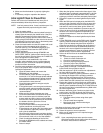
7800 SERIES RM7824A RELAY MODULE
65-0155—1
17
b. As the control attempts to relight the pilot,
increase the pilot pressure immediately until the
FLAME LED comes on, and then slowly turn it
down to obtain a pressure reading just above the
dropout point or until the flame signal increases
to approximately 1.25 Vdc. This step must be
completed within four or ten seconds, depending
on the selected PFEP, or lockout will occur.
c. Turn the pilot back down slightly but not enough
to cause the FLAME LED to go out. (Keep the
pilot gas pressure just above the reading noted in
step 6 above.)
NOTE: Step d requires two people to complete,
one person to open the manual main
fuel valve(s) and one to watch for
ignition.
d. With the sequence in the normal burner run mode,
make sure that the automatic main fuel valve(s) is
open. Smoothly open the manual main fuel shutoff
valve(s) and watch for main burner lightoff.
e. If the main flame is not established within five
seconds or the normal lightoff period specified by
the burner manufacturer, close the manual main
fuel shutoff valve(s) and open the master switch.
Then return to step 6.a. If the burner flame is
established in the normal lightoff period, proceed
to step 10.
7. Recycle the burner and let the sequence advance to
the PILOT IGNITION period.
8. Increase the pilot flame size by increasing its fuel flow
until a smooth main flame is accomplished.
9. Reposition the flame scanner sight tube or use orifices
until the pilot flame signal voltage is approximately
1.25 to 1.50 Vdc.
10. When the main burner lights reliably with the pilot at
turndown, disconnect the manometer (or pressure
gauge) and turn the pilot gas flow up to that
recommended by the equipment manufacturer.
11. If used, remove the bypass jumpers from the subbase
terminals, limits/control or switches.
12. Run the system through another cycle to check for
normal operation.
13. Return the system to normal operation.
Ultraviolet Sensor, Ignition Spark Response
Test (All Ultraviolet Detectors)
Test to be sure that the ignition spark is not actuating the
FLAME LED:
1. Close the pilot and main burner manual fuel shutoff
valve(s).
2. Start the burner and run through the PILOT IGNITION
period. Ignition spark should occur, but the flame signal
should not be more than 0.5 Vdc and the FLAME LED
should not turn on.
3. If the flame signal is higher than 0.5 Vdc and the
FLAME LED does come on, consult the equipment
Operating Manual and resight the detector further out
from the spark, or away from possible reflection. If may
be necessary to construct a barrier to block the ignition
spark from the detector view. Continue adjustments
until the flame signal due to ignition spark is less than
0.5 Vdc.
Response to Other Ultraviolet Sources
Under certain conditions, an ultraviolet detector will respond
to other ultraviolet sources as if it is sensing a flame. These
ultraviolet sources include artificial light, such as
incandescent or fluorescent bulbs, mercury and sodium vapor
lamps or daylight. To check for proper detector operation,
check the Flame Failure Response Time (FFRT) and conduct
Safety Shutdown tests under all operating conditions.
Flame Signal with Hot Combustion
Chambers (All Installations)
After all initial start-up tests and burner adjustments are
completed, operate the burner until the combustion chamber
is at the maximum expected temperature. Observe the
equipment manufacturer warm-up instructions. Recycle the
burner under these hot conditions and measure the flame
signal. Check the pilot alone for non-DSI applications or the
main burner flame for DSI applications.
Check the FFRT of the Flame Amplifier. Lower the setpoint of
the operating controller and observe the time it takes for the
burner flame to go out. This should be within three seconds
maximum.
If the flame signal is too low or unsteady, check the flame
detector temperature. Relocate the detector if the temperature
is too high. If necessary, realign the sighting to obtain the
proper signal and response time. Then if the response time
continues to be too slow, replace the Plug-in Flame Signal
Amplifier.
Safety Shutdown Tests (All Installations)
Perform these tests at the end of Checkout section after all
other tests have been completed. If used, the external alarm
should turn on. Press the RM7824A reset pushbutton to
restart the system.
1. Detect flame 40 seconds after entry to STANDBY.
a. Simulate a flame to cause the flame signal
voltage level to be at least 1.25 Vdc for 30 sec-
onds after the initial 40 second entry into
STANDBY.
b. Safety shutdown will occur.
2. Failure to ignite pilot.
a. Close the pilot and main fuel manual shutoff
valve(s).
b. Depress the reset pushbutton.
c. Start the system.
d. Automatic pilot valve(s) should be energized but
the pilot cannot ignite.
e. Safety shutdown will occur.
3. Loss of flame during RUN.
a. Open the main fuel manual shutoff valve(s). The
manual pilot shutoff valve(s) must also be opened.
b. Depress the reset pushbutton.
c. Start the system. Startup should be normal and
the main burner should light normally.
d. After the sequence is in the normal RUN period
for at least ten seconds with the main burner
firing, close the manual main and pilot fuel shutoff
valve(s) to extinguish the main burner flame.
e. The flame signal should drop below 1.25 Vdc within
three seconds after the main flame goes out.
f. Safety shutdown will occur.


















